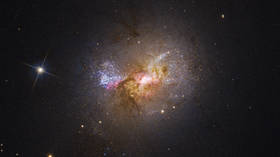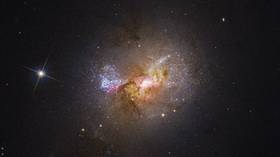By continuing you agree to eChinacities's Privacy Policy .
 Sign up with Google
Sign up with Google
 Sign up with Facebook
Sign up with Facebook
Q: Is it true that a black hole isn't a hole at all?
Watch a TV show on this fact.
3 years 48 weeks ago in Teaching & Learning - Other cities
I heard a blackhole was detected by a drunk foreign junkie in a sleazy bar carpark somewhere in Shanghai.
icnif77:
I won't tolerate much longer all this disregard toward my "black discoveries.." ![]() , i.e. B.holes-Life-Matter ...
, i.e. B.holes-Life-Matter ...
I wanted to say, you were all created by the outer space advanced intelligence ... ![]()
icnif77:
Mama-ibex defies gravity .. with baby-ibex, for the salt deposits in the dam's wall ... ![]() .. i.e. free rock climbing
.. i.e. free rock climbing
https://www.youtube.com/watch?v=RG9TMn1FJzc
I am sure, this will be new for you ...
Black Hole SEEing Giving Birth ... 
https://www.rt.com/news/546674-black-hole-giving-birth-stars/
NASA’s Hubble telescope captures ‘nursery’ of newborn stars connected by an ‘umbilical cord’ to a black hole in a nearby galaxy
A black hole has been observed “triggering the birth” of new stars in a nearby dwarf galaxy, suggesting that the mysterious cosmic phenomena are more than just “villainous” destructive objects that violently consume everything around them.
Using NASA’s Hubble Space Telescope, researchers spotted the black hole at the heart of a galaxy known as Henize 2-10, located some 30 million light years away in the Pyxis constellation. The black hole is apparently adding to the “firestorm of new star formation” in Henize 2-10, according to findings published on Wednesday in the Nature journal.
Given the smaller size of Henize 2-10 – which contains only a tenth of the number of stars in the Milky Way, the black hole is not as massive as those found in larger galaxies. Its mass has been estimated to be around one million times that of the Sun.
In larger galaxies, any material that falls towards the black hole is quickly destroyed by the powerful magnetic fields that surround it. This process creates jets of plasma that travel at almost the speed of light. Gas clouds caught in the blasts become too hot to cool down and form stars.
In contrast, Hubble spectroscopy showed the researchers that the outflow in the Henize 2-10 black hole was only moving at about one million miles per hour. This “low-velocity outflow” arrived at a region with a “dense cocoon” of gas, slamming into it like a “garden hose hitting a pile of dirt” before spreading out and creating newborn star clusters.
The event was likened by NASA to an “umbilical cord” attached to a “bright stellar nursery.” It was captured by Hubble as a “corkscrew-like pattern in the velocities of the gas,” which researcher Amy Reines said was “smoking-gun proof” that the activity was related to a black hole – and not the remains of a supernova explosion at the end of a massive star’s life.
Besides hinting at a larger role played by black holes, the new study might also add to existing knowledge about how they are formed and develop as they grow older. This is information that has “otherwise been lost to time and space,” Reines said.
This has meant that the “outflow” of plasma (ionized gas) from the black hole is comparatively gentler, allowing gas clouds to compress in a way that is conducive to creating new stars.
icnif77:
No, black whole is acting as a nursery ...
You just read a title at my latest astronomi-cal discovery ... ![]()
"Spooky" Object Flashes Radio Waves In Our Galactic Backyard
"This object was appearing and disappearing over a few hours during our observations."
THU JAN 27, AT 4:45
A mysterious object, unlike the world, has ever seen, is unleashing massive bursts of energy every 20 minutes and hides in our galactic backyard.
Astrophysicist Natasha Hurley-Walker discovered the "spooky" object in late 2020 when she and her colleagues were scanning radio signals across the cosmos.
"It was kind of spooky for an astronomer because there's nothing known in the sky that does that," Natasha Hurley-Walker, an astronomer at Curtin University and the International Centre for Radio Astronomy Research in Australia, told NBC News. The research was published Wednesday in the journal Nature.
"This object was appearing and disappearing over a few hours during our observations.
"The occurrences have been seen before — usually as very quick events that flash on and off within seconds or milliseconds or as longer pulses that last days — but radio transients hadn't previously been detected appearing and disappearing over a few hours," Hurley-Walker said.
The object is probably a neutron star or, as some astronomers call it, a "dead" star because it has run out of fuel and collapsed.
She said the object is about "4,000 lightyears away," which is "really quite close to us" considered to be "in our galactic backyard."
Another student researching the mysterious object from Curtin University, Tyrone O'Doherty, said, "somehow it's converting magnetic energy to radio waves much more effectively than anything we've seen before."
Whatever the mystery object is, so far, doesn't appear to be an alien spaceship heading to planet Earth on an invasion mission -- something left-leaning Nobel Prize-winning economist Paul Krugman theorized half a decade ago could be what the global economy needs to unleash a wave of fiscal stimulus (COVID did that).
Maybe with the US economy on the cusp of a recession, if the Federal Reserve embarks on an aggressive rate hike cycle, an alien invasion and or even war with Russia are some of the excuses to unleash another wave of fiscal stimulus. ![]()
![]()
![]() I knew, many of you expected
I knew, many of you expected ![]() I will eventually find ...
I will eventually find ...![]()

Rare ‘missing link’ black hole found – study
An intermediate-mass black hole located in the nearby Andromeda Galaxy fills a ‘large gap’ in the understanding of the cosmic objects
Jan 27, 2022 06:12
Astronomers have discovered a black hole “unlike any other” housed in a star cluster in the nearby Andromeda Galaxy. The “intermediate mass” object is thought to be one of a rare third type of the cosmic phenomena that could be the ‘missing link’ to understanding the evolution of black holes.
The findings, published recently in the Astrophysical Journal, show that the object has a mass 100,000 times greater than the Sun. This makes it smaller than supermassive black holes located at the center of galaxies, but larger than the stellar black holes formed when stars explode.
Using observational data from the Gemini North telescope in Hawaii, the researchers identified the intermediate black hole (IMBH) in a massive star cluster (called B023-G078) that is more than 6 million times the mass of the Sun. The authors argue that the cluster is a “stripped nucleus,” the remnant of a smaller galaxy that fell into a larger one and had its outer stars snatched away by gravitational forces.
Stiggs:
Space is a trippy f**king place. Sometimes I go down the youtube rabbit hole and watch videos like this...
http://www.youtube.com/watch?v=TXfOzhZGtNw
... they can be hard to get your head around. The videos talking about distances especially.
icnif77:
I usually avoid short vids at u-Tube, but ...
It is our measures perception and traveling means on Earth that makes you think about the unimaginable distances and sizes in space.
Traveling in space doesn't resort only to trains, boats, space ships ...
See Michio Kaku and talk about String theory ... you'll get more about wrapping the mind ...
icnif77:
"It's all your fault!", but see this one .... mostly about 'brazillion light years away' & 'in size of ...'
https://www.youtube.com/watch?v=tDZZEaqQPNY
WARNING:
" ... light gets bent & warped ... from such large distances ...".
Now, one just need to wrap that fact around somewhere. ![]()
Wrap, warp & praw-n as Past Participle ... in outer space, English grammar must also be different ... ![]()
![]()
Moreover, I might be homogenious. Watch yer spelling!
This one about the size of Milky Way and its earthy time of resolution around the centre of the galaxy is good, too!
" ... last time the Milky Way was at same spot as today, first dinos were just started to hatch ... on Earth."
https://www.youtube.com/watch?v=uVxrsJ5lZlQ
- « first
- ‹ previous
- 1
- 2
- 3












